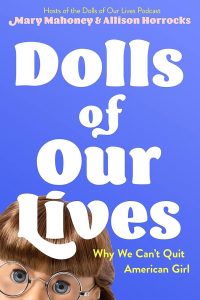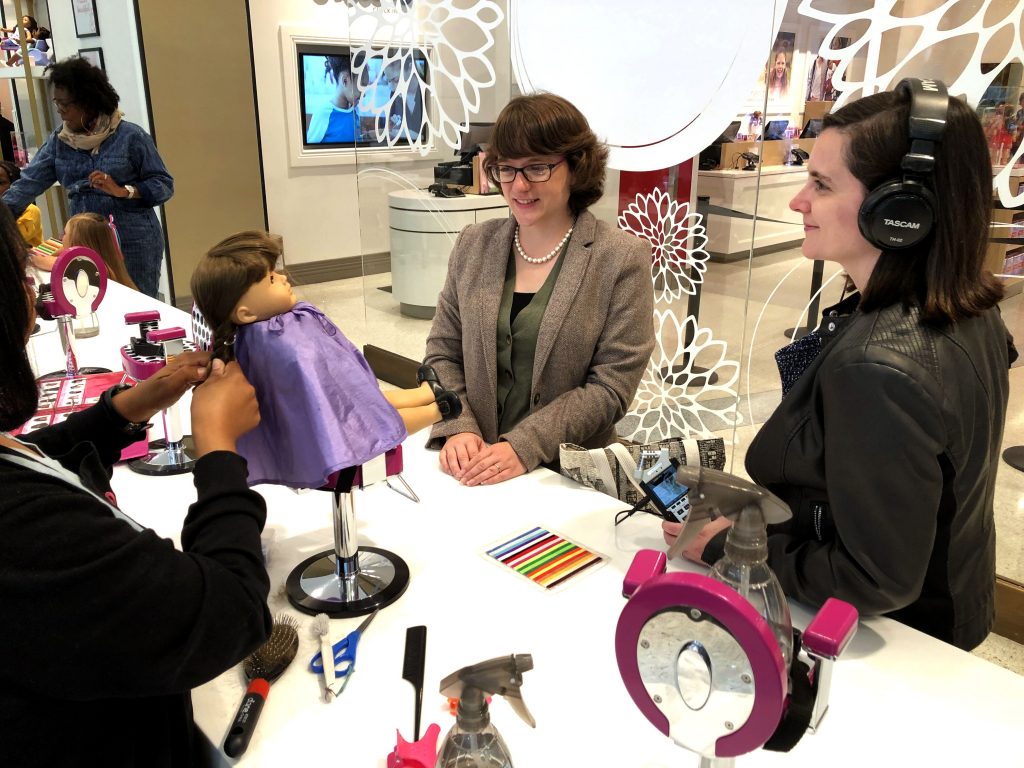In the right hands, dolls can tell all kinds of stories about the human experience. Most children understand this. Greta Gerwig, director of recent Oscar nominee “Barbie,” understands this. So, too, do Mary Mahoney ‘18 Ph.D. and Allison Horrocks ‘16 Ph.D. – historians whose interests in American studies, books, and family culture all converge in their new book “Dolls of Our Lives.”

Released in November, “Dolls of Our Lives” is an offshoot of the eponymous podcast the pair have hosted since 2019. Each episode of the podcast analyzes a specific book in an American Girl character series through the lenses of history and pop culture. (For example, the episode “Classy, Bougie, Ringlets” discusses the book “Samantha Learns a Lesson,” placing it in conversation with other modern-day classics like Selling Sunset.)
In their book, Mahoney and Horrocks get to break away from the American Girl literary world to consider how the brand – its characters, its stories, its publications, and even its merchandise – shaped the real lives of girls (and others) across the country.
“We wanted to expand the mission of our show to not just tell our stories, but to explore what it meant for generations of fans and people for whom it mattered,” says Mahoney.
Living History
The book’s origins feel as magical as receiving a burgundy doll-sized box for a birthday: Mahoney and Horrocks were contacted by an editor from Macmillan Publishers, who had listened to the show and recognized something special. This editor wasn’t alone – the show attracted media buzz from the likes of The New York Times, NPR, and UConn Magazine, while the book prompted a warm-and-fuzzy feature in The New Yorker. As Mahoney and Horrocks know all too well, revisiting the world of American Girl is a surefire way to get people talking.
But the creators are careful not to lean on nostalgia. In contrast to, say, pretending that Molly lives in a post-apocalyptic wasteland ravaged by nuclear war (a fan’s childhood anecdote recounted in the book), their engagement with American Girl’s legacy is marked by careful attention to history and critical analysis.
“I think people who are really drawn to these kinds of conversations, they’re fascinated by reviewing something they loved, or still love, with a different lens and different outlook,” Horrocks says. “And I think that is very different than just reveling in something you used to take pleasure in. … The brand wanted to spark curiosity, and that worked.”
Within the book’s 243 pages, Horrocks and Mahoney trace the evolution of the American Girl brand, from its founding as Pleasant Company by educational entrepreneur Pleasant Rowland in 1986 to its present-day incarnation as a Mattel subsidiary.
They share firsthand interviews with women who helped bring American Girl history to life, among them Mary Wiseman, a Martha Washington living history performer at Colonial Williamsburg; Ingrid Hess, an illustrator who worked on the iconic AG book “The Care and Keeping of You”; and Courtney Price, the first girl who got to trace her own family’s history by being transformed into a paper doll for American Girl magazine.
“I did a lot of 19th century history when I was in grad school, so it’s nice to talk to and write about people who are still with us,” says Mahoney. “Someone I can call on the phone – what a gift!”

Better (Research) Together
For as long as they have been collaborators, Horrocks and Mahoney have never lived in the same state. Mahoney works as a Digital Scholarship Strategist for Trinity College-Hartford; Horrocks works as an interpretive park ranger in Rhode Island. Like their podcast, their book was made possible by virtual collaboration, file-sharing, and the occasional joint excursion to Colonial Williamsburg.
“A lot of times, it feels solitary when you do research – you go to an archive, you’re reading books,” says Mahoney. “But this felt like a joint effort.”
The virtual space in which much American Girl content exists also lent itself to a new kind of historical work, one that took both historians beyond the realm of anything they’d tackled before.
“I think what’s really different is usually you’re visiting an archive that’s been set up by other people,” says Horrocks. “Really, for this, we created the archive: the archive is in our Google Drive, it’s in other people’s Flickr account, it’s in things that people chose to share with us. There isn’t a singular place that you could go to access all these materials, so we’ve had to build up a kind of borrower’s library of all of it.”
This work has allowed us to engage people who think history is not for them.
Historical training like hers, Horrocks says, tends to focus on physical artifacts. This has equipped her well to consider how objects like books, dolls, and accessories actually held meaning for the young people to whom they were important.
“I think what makes [our work] different from a corporate-minded history is, we’re curious about the ephemera in a book,” she says. “We’re curious about how people actually use the products, not just how they were produced and then stored in an archive.”
This democratic approach creates products, like the podcast and book, that virtually everyone can appreciate. Horrocks and Mahoney take the specialized training and knowledge they acquired through their graduate studies and transform them into public-facing scholarship you don’t need an advanced degree to wade through – childhood afternoons spent networking with Felicity and Kaya will suffice.
“This work has allowed us to engage people who think history is not for them – which is the people public historians most want to reach – and actually get them involved or interested in conversations about history that they think didn’t include them or weren’t of interest to them,” says Mahoney. “And that’s probably been the most rewarding public history piece of it for me.”
Molly Gets Kicked Out
Asked which American Girl doll would be most likely to get a UConn history Ph.D., Horrocks doesn’t hesitate.
“It has to be Julie Albright, because of the women’s basketball team,” she says, naming the spunky young San Franciscan who contends with the real-time implementation of Title IX at her elementary school. “I could see her hauling into a 1980s lecture in a power suit.”
Mahoney offers a counterpoint in Kit Kittredge, an aspiring journalist who grows up during the Great Depression.
“Kit could have come of age and been part of the Federal Writers’ Project, perhaps doing oral histories, and then maybe she gets into the UConn history Ph.D. later in life, kind of as a retirement project,” she says.
“Just thinking about it,” Mahoney adds, “I think Molly may have tried to get a Ph.D. in history, but she would have been kicked out for basically doing ‘Great Man’ World War II history.”
For what it’s worth, Mahoney and Horrocks are both self-identified “Molly”s. Thankfully, their collective body of work shows no warning signs of veering into this sort of uncritical hero-worship.
While both historians enjoy the success of their recent publication, they don’t expect to close the book on their work together anytime soon.
“My intention is to keep going, thinking about how I can reach people about public history, using pop culture as a shared language to access historical questions or historical thinking,” says Mahoney. The response to the book, she says, “makes us feel that we’re on the right path, trying to do work that can meet people where they are … and take them somewhere else.”



